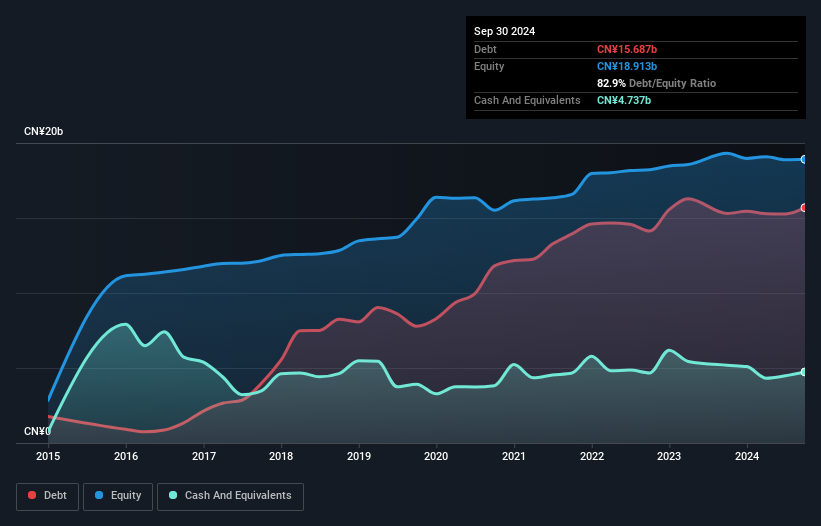Warren Buffett famously said, 'Volatility is far from synonymous with risk.' It's only natural to consider a company's balance sheet when you examine how risky it is, since debt is often involved when a business collapses. As with many other companies Transfar Zhilian Co., Ltd. (SZSE:002010) makes use of debt. But is this debt a concern to shareholders?
What Risk Does Debt Bring?
Debt assists a business until the business has trouble paying it off, either with new capital or with free cash flow. In the worst case scenario, a company can go bankrupt if it cannot pay its creditors. However, a more common (but still painful) scenario is that it has to raise new equity capital at a low price, thus permanently diluting shareholders. Of course, plenty of companies use debt to fund growth, without any negative consequences. When we examine debt levels, we first consider both cash and debt levels, together.
Check out our latest analysis for Transfar Zhilian
How Much Debt Does Transfar Zhilian Carry?
The chart below, which you can click on for greater detail, shows that Transfar Zhilian had CN¥15.7b in debt in September 2024; about the same as the year before. However, because it has a cash reserve of CN¥4.74b, its net debt is less, at about CN¥10.9b.

How Healthy Is Transfar Zhilian's Balance Sheet?
Zooming in on the latest balance sheet data, we can see that Transfar Zhilian had liabilities of CN¥13.2b due within 12 months and liabilities of CN¥10.1b due beyond that. Offsetting this, it had CN¥4.74b in cash and CN¥6.46b in receivables that were due within 12 months. So its liabilities outweigh the sum of its cash and (near-term) receivables by CN¥12.1b.
Given this deficit is actually higher than the company's market capitalization of CN¥10.4b, we think shareholders really should watch Transfar Zhilian's debt levels, like a parent watching their child ride a bike for the first time. Hypothetically, extremely heavy dilution would be required if the company were forced to pay down its liabilities by raising capital at the current share price.
We use two main ratios to inform us about debt levels relative to earnings. The first is net debt divided by earnings before interest, tax, depreciation, and amortization (EBITDA), while the second is how many times its earnings before interest and tax (EBIT) covers its interest expense (or its interest cover, for short). This way, we consider both the absolute quantum of the debt, as well as the interest rates paid on it.
Transfar Zhilian has a rather high debt to EBITDA ratio of 8.1 which suggests a meaningful debt load. But the good news is that it boasts fairly comforting interest cover of 4.0 times, suggesting it can responsibly service its obligations. More concerning, Transfar Zhilian saw its EBIT drop by 7.9% in the last twelve months. If that earnings trend continues the company will face an uphill battle to pay off its debt. There's no doubt that we learn most about debt from the balance sheet. But ultimately the future profitability of the business will decide if Transfar Zhilian can strengthen its balance sheet over time. So if you're focused on the future you can check out this free report showing analyst profit forecasts.
Finally, a company can only pay off debt with cold hard cash, not accounting profits. So we clearly need to look at whether that EBIT is leading to corresponding free cash flow. Over the last three years, Transfar Zhilian recorded negative free cash flow, in total. Debt is far more risky for companies with unreliable free cash flow, so shareholders should be hoping that the past expenditure will produce free cash flow in the future.
Our View
To be frank both Transfar Zhilian's conversion of EBIT to free cash flow and its track record of managing its debt, based on its EBITDA, make us rather uncomfortable with its debt levels. And furthermore, its EBIT growth rate also fails to instill confidence. After considering the datapoints discussed, we think Transfar Zhilian has too much debt. That sort of riskiness is ok for some, but it certainly doesn't float our boat. There's no doubt that we learn most about debt from the balance sheet. However, not all investment risk resides within the balance sheet - far from it. We've identified 4 warning signs with Transfar Zhilian (at least 1 which can't be ignored) , and understanding them should be part of your investment process.
When all is said and done, sometimes its easier to focus on companies that don't even need debt. Readers can access a list of growth stocks with zero net debt 100% free, right now.
Valuation is complex, but we're here to simplify it.
Discover if Transfar Zhilian might be undervalued or overvalued with our detailed analysis, featuring fair value estimates, potential risks, dividends, insider trades, and its financial condition.
Access Free AnalysisHave feedback on this article? Concerned about the content? Get in touch with us directly. Alternatively, email editorial-team (at) simplywallst.com.
This article by Simply Wall St is general in nature. We provide commentary based on historical data and analyst forecasts only using an unbiased methodology and our articles are not intended to be financial advice. It does not constitute a recommendation to buy or sell any stock, and does not take account of your objectives, or your financial situation. We aim to bring you long-term focused analysis driven by fundamental data. Note that our analysis may not factor in the latest price-sensitive company announcements or qualitative material. Simply Wall St has no position in any stocks mentioned.
About SZSE:002010
Transfar Zhilian
Engages in the chemicals and logistics business in China and internationally.
Proven track record with adequate balance sheet.
Market Insights
Community Narratives




